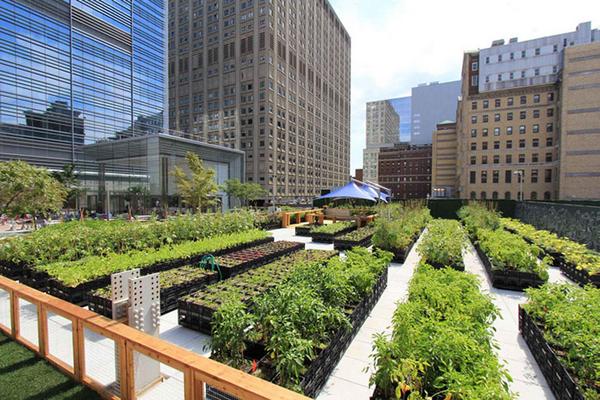Not known Details About City Blooming
Not known Details About City Blooming
Blog Article
The 9-Minute Rule for City Blooming
Table of ContentsThe smart Trick of City Blooming That Nobody is Talking AboutGetting My City Blooming To WorkThe Facts About City Blooming RevealedRumored Buzz on City BloomingCity Blooming Things To Know Before You Get This
Intrigued in growing food for sale in the City of Chicago? Below is a list of often asked inquiries pertaining to the guidelines and laws that cultivators ought to think about when planning a metropolitan agriculture job.
The zoning amendment does not modify any kind of other codes managing composting, building authorizations, buying or renting City had residential property, business licenses or environmental contamination. There are existing codes that control these problems and they continue to be in full effect and may apply to your task. Community gardens are typically owned or taken care of by public entities, public companies or community-based companies and kept by volunteers.
Urban farms grow food that is planned to be marketed, either on a not-for-profit or for-profit basis. As a result of their industrial objective, urban ranches call for a company license. Yes. A neighborhood garden is allowed to sell surplus generate that was grown on site if the sales are accessory or subordinate to the yard's key purpose explained over.
The Main Principles Of City Blooming
Composting is allowed however just for plant product that is generated and made use of on website. The amount of compost product can not exceed 25 cubic lawns at any type of given time according to the criteria in 7-28-715 of the City's Municipal Code. Yes. Since the soil at a lot of brand-new yard sites needs amending, garden compost, dirt, wood chips, or various other products can be gotten to create or enhance the expanding area - garden care.

If a building authorization is called for then the hoophouse will be considered an accessory building. You can figure out even more regarding the building authorization requirements by speaking to the Department of Buildings. The 25,000-square-foot size limit is planned to stop a single community yard from dominating a provided block or detracting from the block's existing residential or commercial character.
The limit does not relate to gardens situated in Public Open Area (POS) areas. Can there be greater than one community yard that is 25,000 square feet on a single block? Yes. The dimension limitation uses to specific gardens, not to private blocks. No. Secure fencing is not required, nonetheless, yards that have huge parking lot may be called for to mount fence or other landscaping features.
City Blooming Can Be Fun For Anyone
B1 & B2 areas call for that all industrial use tasks be carried out inside your home. R areas limit industrial task. The laws show the function and intent of the Zoning Code. Is secure fencing required for urban ranches? Yes. Fences might be called for, in addition to landscaping and testing, for specific auto parking areas and exterior job or storage areas depending upon location and the details task happening.
Urban ranches call for structure permits and zoning authorizations prior to building and construction (sustainability). Other forms of city review might be required depending on specific structures, tasks, dimension, landscaping, licensing, public health and stormwater monitoring concerns.
The Department of Company Affairs and Consumer Defense can aid figure out the certain type of business certificate that's required. Off road auto parking is required for most commercial jobs in Chicago. The needed number of car parking spaces is based on the number of staff members working on site and not the square footage of the expanding room.
The Facts About City Blooming Uncovered
:max_bytes(150000):strip_icc()/womanonrooftopurbangarden-7fffbb3897ac48f390d94b9545d4d082.jpg)
A city farm can offer compost look here product created on website, nevertheless, the operation needs to conform with the policies in 7-28-715 of the Chicago Municipal Code. Aquaponic systems are enabled inside your home on urban farms in many zoning areas.
Up to 5 hives or nests of honey might be maintained as an accessory use. Beekeepers should sign up with the Illinois Division of Agriculture. For more info about the recommended zoning modification you might contact the Division of Real Estate and Economic Advancement, Bureau of Preparation and Zoning at 312.744.8563.
Farming in cities and urban areas An urban ranch in Chicago. Urban farming describes numerous techniques of growing. https://www.topratedlocal.com/city-blooming-reviews, processing, and dispersing food in metropolitan locations. The term also relates to the location tasks of animal husbandry, tank farming, beekeeping, and gardening in an urban context. Urban agriculture is identified from peri-urban farming, which takes location in country locations beside suburbs.
How City Blooming can Save You Time, Stress, and Money.
, who look for to create social networks established on a common ethos of nature and community holism. These networks can establish by way of formal institutional assistance, becoming incorporated into local community preparation as a "transition town" motion for lasting city growth.
In either situation, the extra straight access to fresh vegetable, fruit, and meat products that might be realised with city agriculture can improve food safety and food safety while reducing food miles, resulting in lower greenhouse gas exhausts, consequently adding to climate adjustment reduction. Some of the initial evidence of metropolitan agriculture originates from Mesopotamia.
Report this page